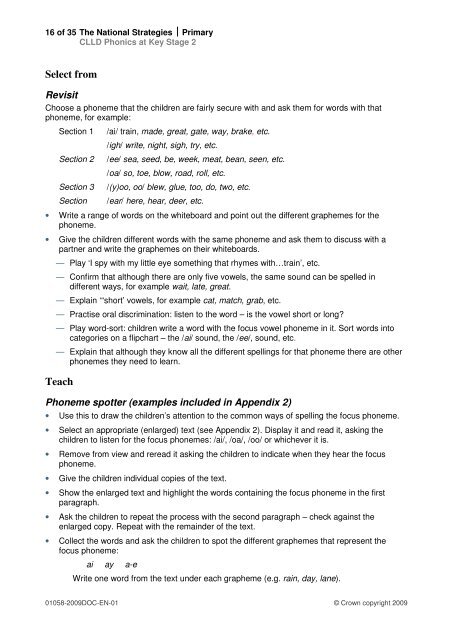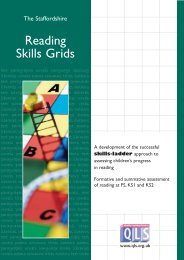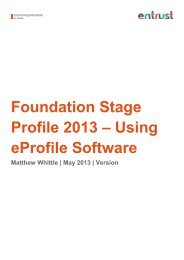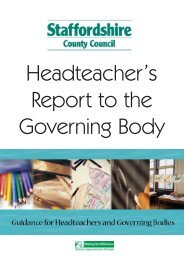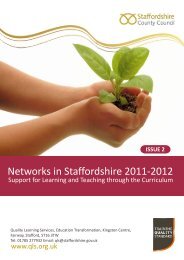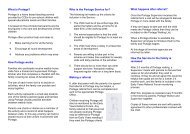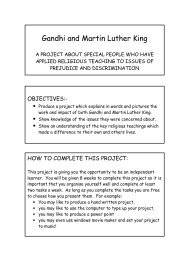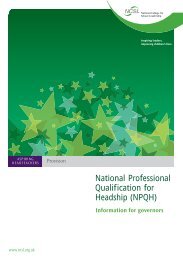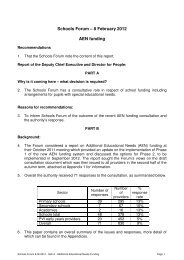CLLD Phonics at Key Stage 2 - School-Portal.co.uk
CLLD Phonics at Key Stage 2 - School-Portal.co.uk
CLLD Phonics at Key Stage 2 - School-Portal.co.uk
You also want an ePaper? Increase the reach of your titles
YUMPU automatically turns print PDFs into web optimized ePapers that Google loves.
16 of 35 The N<strong>at</strong>ional Str<strong>at</strong>egies ⏐ Primary<br />
<strong>CLLD</strong> <strong>Phonics</strong> <strong>at</strong> <strong>Key</strong> <strong>Stage</strong> 2<br />
Select from<br />
Revisit<br />
Choose a phoneme th<strong>at</strong> the children are fairly secure with and ask them for words with th<strong>at</strong><br />
phoneme, for example:<br />
Section 1 /ai/ train, made, gre<strong>at</strong>, g<strong>at</strong>e, way, brake, etc.<br />
/igh/ write, night, sigh, try, etc.<br />
Section 2 /ee/ sea, seed, be, week, me<strong>at</strong>, bean, seen, etc.<br />
/oa/ so, toe, blow, road, roll, etc.<br />
Section 3 /(y)oo, oo/ blew, glue, too, do, two, etc.<br />
Section /ear/ here, hear, deer, etc.<br />
• Write a range of words on the whiteboard and point out the different graphemes for the<br />
phoneme.<br />
• Give the children different words with the same phoneme and ask them to discuss with a<br />
partner and write the graphemes on their whiteboards.<br />
— Play ‘I spy with my little eye something th<strong>at</strong> rhymes with…train’, etc.<br />
— Confirm th<strong>at</strong> although there are only five vowels, the same sound can be spelled in<br />
different ways, for example wait, l<strong>at</strong>e, gre<strong>at</strong>.<br />
— Explain ‘“short’ vowels, for example c<strong>at</strong>, m<strong>at</strong>ch, grab, etc.<br />
— Practise oral discrimin<strong>at</strong>ion: listen to the word – is the vowel short or long?<br />
— Play word-sort: children write a word with the focus vowel phoneme in it. Sort words into<br />
c<strong>at</strong>egories on a flipchart – the /ai/ sound, the /ee/, sound, etc.<br />
— Explain th<strong>at</strong> although they know all the different spellings for th<strong>at</strong> phoneme there are other<br />
phonemes they need to learn.<br />
Teach<br />
Phoneme spotter (examples included in Appendix 2)<br />
• Use this to draw the children’s <strong>at</strong>tention to the <strong>co</strong>mmon ways of spelling the focus phoneme.<br />
• Select an appropri<strong>at</strong>e (enlarged) text (see Appendix 2). Display it and read it, asking the<br />
children to listen for the focus phonemes: /ai/, /oa/, /oo/ or whichever it is.<br />
• Remove from view and reread it asking the children to indic<strong>at</strong>e when they hear the focus<br />
phoneme.<br />
• Give the children individual <strong>co</strong>pies of the text.<br />
• Show the enlarged text and highlight the words <strong>co</strong>ntaining the focus phoneme in the first<br />
paragraph.<br />
• Ask the children to repe<strong>at</strong> the process with the se<strong>co</strong>nd paragraph – check against the<br />
enlarged <strong>co</strong>py. Repe<strong>at</strong> with the remainder of the text.<br />
• Collect the words and ask the children to spot the different graphemes th<strong>at</strong> represent the<br />
focus phoneme:<br />
ai ay a-e<br />
Write one word from the text under each grapheme (e.g. rain, day, lane).<br />
01058-2009DOC-EN-01 © Crown <strong>co</strong>pyright 2009


